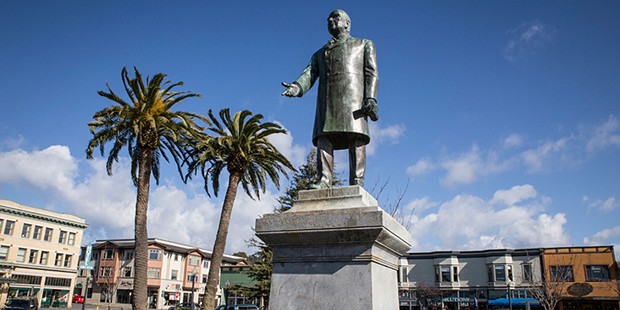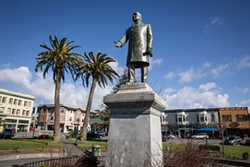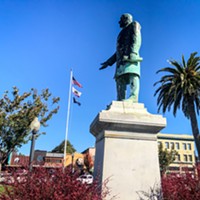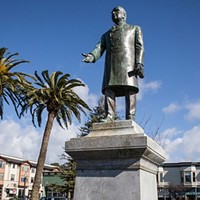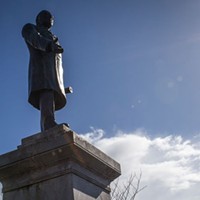The Long Goodbye
Haig Patigian's McKinley and Erich Ragsdale's small pleasures
By Gabrielle Gopinath[
{
"name": "Top Stories Video Pair",
"insertPoint": "7",
"component": "17087298",
"parentWrapperClass": "fdn-ads-inline-content-block",
"requiredCountToDisplay": "1"
}
]
Now that the Arcata City Council has voted 4-1 to remove the statue of William McKinley from the Arcata Plaza, sculptor Haig Patigian's larger than life bronze portrait will be coming down from the massive pedestal where it has held court since 1906 — eventually. The process of removal is slated to take many months. As we begin this long goodbye, let's make the most of the time we have left with "President William McKinley," doing the artist a solid by actually looking at the sculpture he cast in bronze.
The figure of McKinley stands 8 1/2 feet tall. It is positioned atop a stone pedestal that is more than 10 feet high. The work is confidently executed and competently cast; Patigian's McKinley appears grave and yet untroubled, secure in his conviction regarding the lasting significance of his achievement. Patigian does not seek to flatter his subject by rendering him approachable or "humanizing" him, as a contemporary might. (His flattery takes other forms.)
The military erectness of the figure's posture and the rigid tailoring of the clothes communicate stern rectitude; the neutral, unsmiling facial expression conveys a dignified reserve that, unfortunately for its subject, accords poorly with contemporary modes of self-presentation. The outstretched hand serves as double entendre: part paternal benevolence, part oratory flourish. The figure looms over the heads of its audience like a brontosaurus in a diorama, staring nobly off into the middle distance — relic of a time when the term "mansplaining" had yet to be crafted.
In the 112 years that have passed since the statue's installation, a lot about the circumstances that prompted its original placement have been forgotten. Even so, it is still possible to appreciate the fact that Patagian was a pro. His polished rendering makes it possible even now for us to get the gist: This man is in charge. He (and the institutions he represents) know and want what's best for us. How individual viewers feel about that proposition will likely influence their sentiments regarding this artwork's impending departure from the civic center.
The statue's placement here in Arcata, somewhat whimsical from the get-go, does not appear to have been the result of any local enthusiasm for the nation's 25th president. Nor was it sustained by any meaningful connection that the president maintained with this place by virtue of birth, business or personal affinity. (Ohio native McKinley came no closer than San Francisco.) If there was any public component to the process of placing the sculpture, its record has not been preserved.
No, the statue's arrival in Humboldt was a one-off, a windfall of sorts. It seems likely that it might not have happened at all were it not for two unrelated events. First, on Sept. 5, 1901, Polish-American anarchist Leon Czolgosz sprang to the front of a reception line at the Temple of Music in the Pan-American Exposition in Buffalo, New York and shot President William McKinley two times in the abdomen; the president would die nine days later. Second, on April 18, 1906, the Great Earthquake struck San Francisco and caused thousands of casualties, leveling most of the city and blitzing much of what was left with fire.
Patigian's foundry and studio burned, but his recently cast sculpture improbably survived this cataclysm. Arcata McKinley supporter George Zehnder, who commissioned the statue, presented it to the city in the earthquake's aftermath as a memorial, along with its massive pedestal — footing the bill for the work's purchase price, transportation by steamer to Eureka and installation.
This is a strange moment in terms of our national relationship to monuments. The discourse surrounding public art has seldom been so intense. Rarely has it occupied such a prominent a position in the news. The very possibility of meaningful public art in a democratic society requires possibility of consensus and the existence of clearly articulated, shared societal goals. At a moment when American politics and culture are increasingly dominated by tribalist, hyperbolically oppositionist attitudes, such consensus is increasingly difficult to conjure. Where that will leave Arcata, as it searches for the McKinley statue's replacement, is anyone's guess.
These days, to view the sculpture on an average weekday morning is to see Patigian's opus acquiring a whole new, unexpected layer of meaning. As dawn breaks over Humboldt Bay, the huge bronze man in the highly structured clothes of yesteryear is gradually surrounded by the collection of unhoused people who dominate the plaza's public space six days a week. A tableau emerges. Here are the emissaries of the new tribalism, clustering huddled at McKinley's feet. The daily assemblage indicts a society riven by addiction, lack of opportunity and economic inequality even worse than that of McKinley's time, which is saying something. As unwelcome as it may be, this social context resuscitates the old bronze as art and makes it, for the first time in a long while, a sight with the power to disturb complacency.
By way of contrast, Erich Ragsdale's elegant constructions, on display at the Sanctuary this month, present no intractable problems — just a series of intimate pleasures, running long on the charm of the obsolete. Austin native and recent Humboldt arrival Ragsdale trawled the county's thrift shops and antiquaries in search of materials with which to construct these jewel-like assemblages. In meticulously fashioned set pieces, many of which contain their own sources of illumination, elements from 1930s Mechano toy sets come together with late 19th century stereogram viewers, 1960s Viewmasters, 3-D photos and more. Give them a look and a look through.
Erich Ragsdale's work is on view at the Sanctuary Arcata, 1301 J St., Arcata, throughout March. The artist will be screening unique archival prints of his hand-painted films during Arts Arcata on Friday, March 9 from 5:30 to 9 p.m. Call 822-0898 or visit www.sanctuaryarcata.org.
Speaking of...
-

Music Tonight: Saturday, April 6
Apr 6, 2024 -
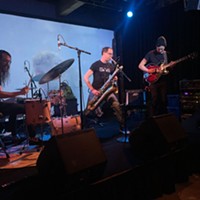
Music Tonight: Monday, March 25
Mar 25, 2024 -
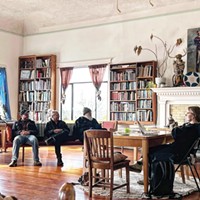
Magical, Cozy Winter Cafés
Feb 22, 2024 - More »
more from the author
-
Nancy Tobin's CRy-Baby Installation at CR
- Feb 22, 2024
-
Truth Units
Bachrun LoMele's Burn Pile/The Andromeda Mirage at the Morris Graves
- Sep 7, 2023
-
Ruth Arietta's Illusory Interiors at Morris Graves Museum of Art
- Aug 10, 2023
- More »
